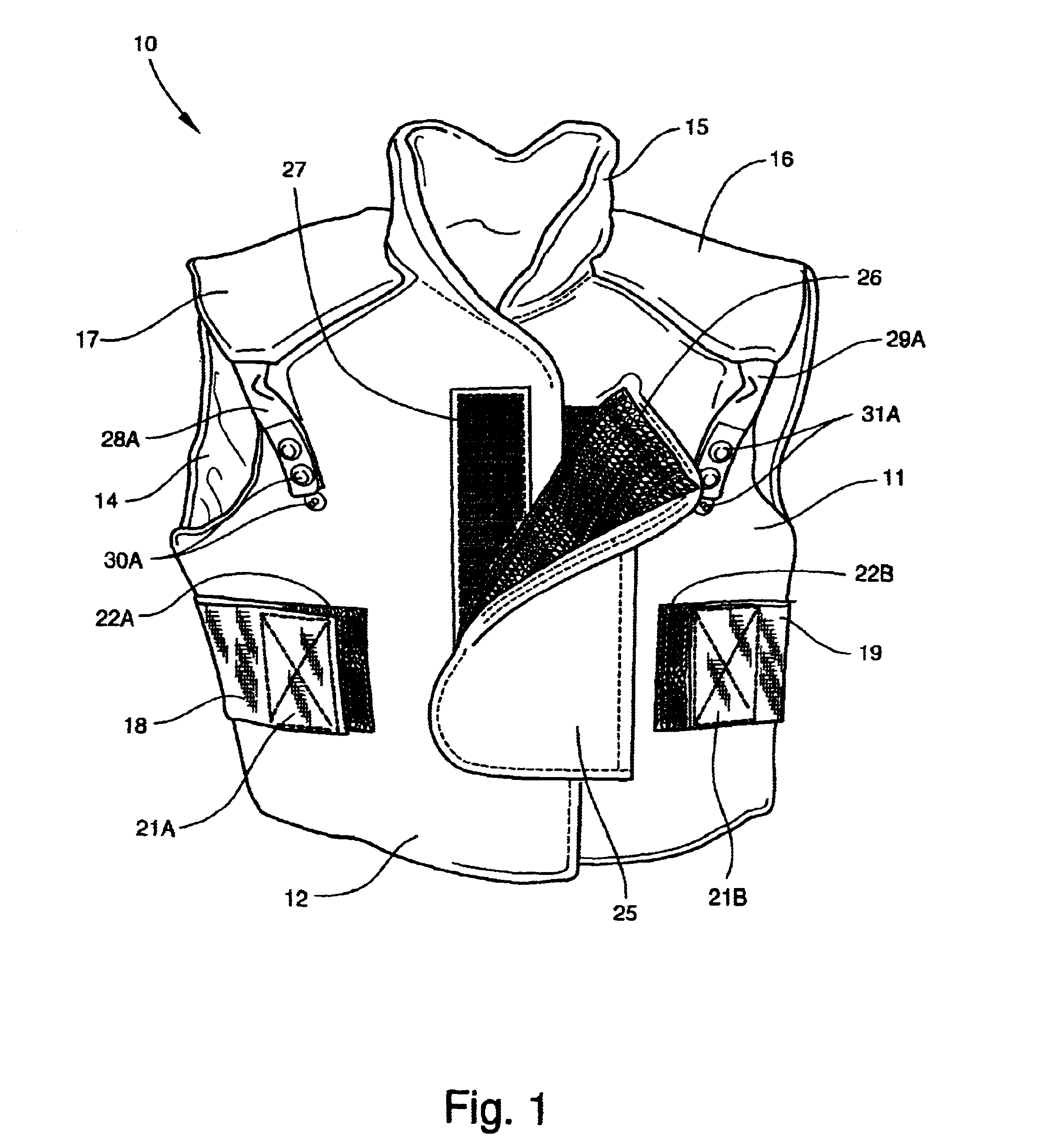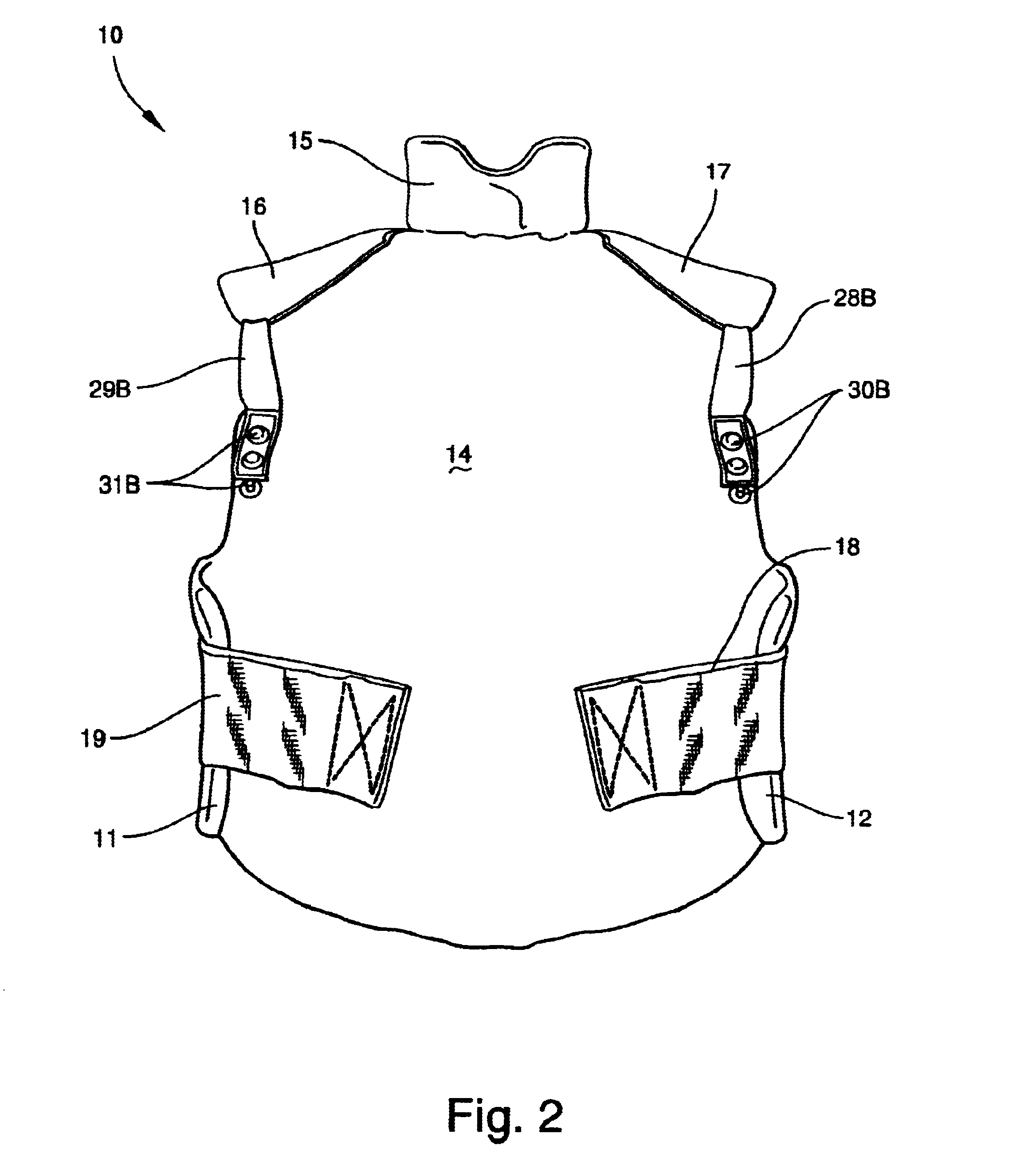Lightweight soft body-armor product
a technology of soft body and armor, applied in the direction of protective equipment, armour plates, weapons, etc., can solve the problems of general undesirable use in certain military applications, and achieve the effect of reducing overall weight and increasing ballistic resistance performan
- Summary
- Abstract
- Description
- Claims
- Application Information
AI Technical Summary
Benefits of technology
Problems solved by technology
Method used
Image
Examples
example 1
A ballistic panel including 27 overlying plies of 840 denier, plain weave KEVLAR.RTM.129 material with a 31.times.31 weave construction and an areal density of 1.25 lbs. / sq. ft. achieved a V50 ballistic test performance at a minimum 1925 feet per second using a .22 caliber, 17 grain FSP at 0 degrees obliquity. The physical characteristics of KEVLAR.RTM.129 are as follows:
The overall weight of a medium size vest incorporating these panels in the front sections, back, collar, and shoulder shields is approximately 8.5 pounds. The V50 ballistic test limit was obtained for impacts on an 18".times.18" test cloth constructed according to Example One above. The V50 ballistic test limit is the average of 10 fair impact velocities consisting of the five lowest complete penetration velocities and five highest partial penetration velocities. The spread for the 10 velocities was not greater than an allowable range of 150 feet per second (fps). The V50 ballistic limit was determined by averaging ...
example two
A ballistic panel including 25 overlying plies of 850 denier, plain weave KEVLAR.RTM. KM2 material with 31.times.31 construction and an areal density of 1.20 lbs. / sq. ft. achieved a V50 ballistic test performance at a minimum 1925 feet per second using a .22 caliber, 17 grain FSP at 0 degrees obliquity. The physical characteristics of KEVLAR.RTM. KM2 are as follows:
The overall weight of the medium size vest incorporating these panels in the front sections, back, collar, and shoulder shields is approximately 8.3 pounds. The V50 ballistic test limit was obtained for impacts on an 18".times.18" test cloth constructed according to Example Two above. The V50 ballistic test limit is the average of 10 fair impact velocities consisting of the five lowest complete penetration velocities and five highest partial penetration velocities. The spread for the 10 velocities was not greater than an allowable range of 150 feet per second (fps). The V50 ballistic limit was determined by averaging the ...
example three
A ballistic panel including 30 overlying plies of 600 denier, plain weave KEVLAR.RTM. KM2 material with 35.times.35 construction and an areal density of 1.10 lbs. / sq. ft. achieved a V50 ballistic test performance at a minimum 1925 feet per second using a .22 caliber, 17 grain FSP at 0 degrees obliquity. The physical characteristics of KEVLAR.RTM. KM2 are as follows:
The overall weight of the medium size vest incorporating these panels in the front sections, back, collar, and shoulder shields is approximately 8.1 pounds. The V50 ballistic test limit was obtained for impacts on an 18".times.18" test cloth constructed according to Example Three above. The V50 ballistic test limit is the average of 10 fair impact velocities consisting of the five lowest complete penetration velocities and five highest partial penetration velocities. The spread for the 10 velocities was not greater than an allowable range of 150 feet per second (fps). The V50 ballistic limit was determined by averaging th...
PUM
 Login to View More
Login to View More Abstract
Description
Claims
Application Information
 Login to View More
Login to View More - R&D
- Intellectual Property
- Life Sciences
- Materials
- Tech Scout
- Unparalleled Data Quality
- Higher Quality Content
- 60% Fewer Hallucinations
Browse by: Latest US Patents, China's latest patents, Technical Efficacy Thesaurus, Application Domain, Technology Topic, Popular Technical Reports.
© 2025 PatSnap. All rights reserved.Legal|Privacy policy|Modern Slavery Act Transparency Statement|Sitemap|About US| Contact US: help@patsnap.com



